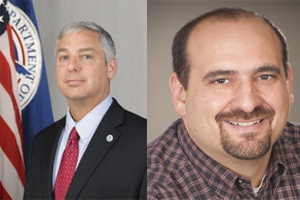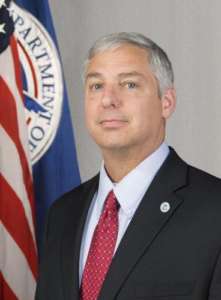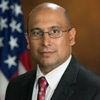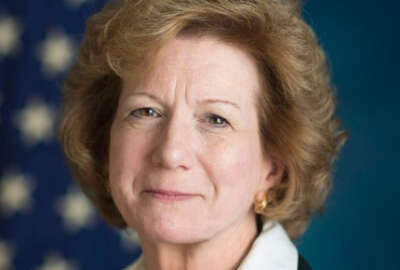
Exclusive
CIOs at HHS, TSA, CTO at Justice leaving federal service
Long-time data guru Tom Beach joins the FDA while GSA shuffles some seats after Carlton Shufflebarger retires after 37 years in government.
As summer turns to fall, changes comes not just to the leaves on trees, but also within the ranks of federal technology and acquisition executives.
Retirements, new jobs inside and out of government and the continued churn of senior executives brings those feelings that turn us shades of reds, oranges and browns inside and out.
By the end of December, two agency chief information officers and one chief technology officer will have left their respective positions.
Federal News Network has confirmed that Russ Roberts, the Transportation Security Administration’s CIO, is retiring on Dec. 31; Janet Vogel, the acting CIO at the Department of Health and Human Services, will be retiring this month; And finally, Ron Bewtra, the Justice Department CTO, is leaving on Dec. 17 to join the private sector.
Roberts is leaving TSA after spending almost four years as its CIO and worked more than seven years in the CIO’s office, joining as the deputy CIO in 2015.

He joined TSA in 2004 and worked on several mission-related projects before becoming deputy CIO. These included managing all technologies and services provided by Secure Flight and the Transportation Vetting System. He also served as TSA’s executive director for mission essential services in the Office of Intelligence and Analysis, general manager for security threat assessment operations in the Office of Law Enforcement/Federal Air Marshal Service and in various leadership assignments overseeing TSA’s criminal, immigration and terrorism vetting program portfolio.
During his tenure as TSA CIO, Roberts set up a digital services team about a year ago to accelerate the development of new capabilities. The digital services team led an effort to turn a manual process into a digital one for Transportation Security Officers to schedule shifts and vacations.
He also drove TSA toward a DevSecOps approach with a goal of making the agency a software-as-a-service (SaaS)-first organization.
Additionally, Roberts was a CIO who tried to keep TSA ahead of the technology curve, such as by moving to Windows 10, by upgrading laptops and desktops and by consolidating infrastructure and data centers.
A TSA spokeswoman confirmed Roberts is leaving, but didn’t say who would be interim CIO. TSA’s deputy CIO is Robert Fortner.
6 CIOs in 6 years at HHS
At HHS, Vogel is retiring after more than 40 years in government, including the last three-plus years with the agency where she has been chief information security officer and then acting CIO.

“My work colleagues have repeatedly risen to address challenges, and together we have succeeded in removing monumental hurdles, and in raising the bar on accomplishments. It takes a team – so – Thank You!” Vogel wrote in an email to colleagues, which Federal News Network obtained. “I am so proud to have worked side-by-side with so many great people. While I will miss each of you, I am looking forward to new challenges and new adventures. A sense of new-found freedom has entered my consciousness. It’s been great working with all of you, and I truly wish you success and happiness.”
With Vogel leaving, HHS will be moving to its seventh CIO in six years, both permanent and acting. Vogel replaced Perryn Ashmore, who joined Oracle in May after nine months as CIO, who replaced Jose Arrieta who unexpectedly resigned in August 2020.
Since Frank Baitman left in December 2015, HHS has moved from permanent to acting back to permanent and back to acting over the last six years.
That has led some to question both why and whether the HHS CIO needs to be converted to a political position.
As for Vogel, her time at HHS will be more remembered for her work as a CISO than as CIO. It’s not that she didn’t push change across HHS, but six months in the role isn’t a lot of time to make a huge impact.
Among Vogel’s biggest accomplishments as CISO is the overhaul of the Health Sector Cybersecurity Coordination Center (HC3) to ensure the most timely and valuable cyber threat intelligence is provided to healthcare providers, companies and other stakeholders.
Vogel also brought a sense of creativity to cybersecurity training, launching an “escape room” cyber training concept and applying a new risk framework to mobile devices when HHS executives traveled abroad.
Justice CTO heading to private sector
At Justice, Bewtra has been CTO since 2015 and joined the government in 2003 as the head of high performance computing and IT services at the National Oceanic and Atmospheric Administration. Before that, he served in executive roles with industry.
Bewtra also has been the co-chairman of the CIO Council’s Innovation Committee since 2018 and chairman of the Federal IPv6 Task Force.
As the Justice CTO, Bewtra focused on setting the strategic technology direction for the department and supporting on key projects, specifically around artificial intelligence, data management, geospatial data, analytics and cloud computing.

He also led the development and implementation of the department’s network and cloud roadmaps, and the development of a departmentwide technical reference architecture.
Bewtra confirmed his last day is Dec. 17, but said he didn’t have anything more to offer about what he plans to do next.
Along with those three executives, there have been several other moves that are notable.
You may have missed that the Federal Communications Commission CIO Francisco Salguero left in October to join Salesforce as a director and digital acceleration architect. He served as the FCC CIO for almost two years and spent more than 15 years at the Agriculture Department in a variety of technology executive roles, including his last two-plus years as the deputy CIO.
Another significant change came to the Office of the Federal CIO where chief of staff Jordan Burris joined the private sector.
Burris served more than four years in the OFCIO. His last day was Nov. 12 and he joined Socure, an identity management firm, on Dec. 6 as its senior director for product market strategy for the public sector.
“There is never a good stopping point as public service is a relay race. I was called to serve and we did our best to solve problems,” Burris said in an interview. “In my time at OMB, I worked on a plethora of issues and as I was evaluating what to do next, I felt the urgency to help improve and make more secure the use of digital identities, especially to ensure diversity and inclusion challenges. This is an issue I’m passionate about.”

Burris said he’s most proud of his work at OMB to help rescind outdated technology policies, the update to the identity access management and credentialing policy and with the aftermath of the SolarWinds cyber incident.
“I spent a great deal of time partnering with public sector leaders, helping them to recognize and overcome the barriers and requirements they have to meet on top of meeting their mission,” he said. “At Socure, my goal and focus will be to continue those partnerships and continue to build momentum to make meaningful progress around identity and access management and combating identity fraud.”
The other executive on the move you may have missed was Steve Luczynski, the first lead of the COVID Task Force at the Cybersecurity and Infrastructure Security Agency in the Homeland Security Department.
Luczynski said on a post on LinkedIn that he was moving back to the private sector, but hasn’t announced a new position yet.
“I’m proud of the work we did to bolster the cyber and physical security of the numerous entities involved in the research and development, manufacture, and distribution of vaccines. I’m grateful for the opportunity to lead such an incredibly talented team of experts from the private sector and federal government. We had a direct impact on preventing the further loss of American lives,” he wrote in a post. “In parallel, we pushed new ideas for a young agency, and as my deputy stated so well, ‘We exposed cracks in established processes and ways of thinking,’ that needed to see the light of day. We engaged other government agencies to leverage CISA’s authorities and cadre of experts to lead cybersecurity efforts across the healthcare sector. There is a tremendous wealth of talent available to address the complex cyber and physical security issues faced by all the critical infrastructure sectors which enable our national critical functions. I appreciate getting to see their work firsthand, and I know their success will only continue to grow.”
Luczynski previously worked as the deputy director for cyber plans and operations for the Defense Department and for the Air Force as its director of operations for the J3 at U.S. Central Command.
GSA, FDA shuffle leadership chairs
It’s wasn’t all bad news in terms of executives moving to new roles.
Long-time chief data guru at the Commerce Department and the Patent and Trademark Office Tom Beach took on a new role at the Food and Drug Administration in HHS.
Beach wrote on LinkedIn that he is now the director of data governance at FDA.
“It is with gratitude and honor that I take the Oath of Office again for my new role at the FDA. I am doubling down on the fact that public servants are just that — servants of the people,” he wrote in a post. “I look forward to joining team FDA as the director of data governance in support of its incredibly important mission and serving the American people. Much appreciation to all those who help make this happen and ready to roll up my sleeves.”
Beach worked at PTO for 17 years in an assortment of roles, including starting as a patent examiner and rising to become the chief data strategist. He joined the Commerce Department as its acting chief data officer in June 2020 before leaving to join the FDA in November.
Finally, there was some shuffling of the chairs at the General Services Administration.
First, Carlton Shufflebarger, the acting director of IT services in the Federal Acquisition Service, is retiring after 37 years in government on Dec 17.
“The hard work and dedication of leaders like Carlton is at the foundation of everything our agency accomplishes. It’s efforts like his that have helped our Office of Information Technology Category support agencies across government to achieve their missions,” wrote Laura Stanton, the assistant commissioner for the Office of Information Technology Category (ITC) in FAS, in an email to staff obtained by Federal News Network.
Shufflebarger joined GSA in 2008 after spending 19 years at the Postal Service.
As acting director of IT services, he was responsible for managing a portfolio of contracts, including governmentwide acquisition contracts such as Alliant 2, 8(a) STARS II, VETS 2 and the multiple award schedule special item numbers (SINs) for IT, professional services, training courses, electronic commerce, health IT services and automated contact center solutions.
“During this time, he led several important GSA initiatives such as the transition to a new operating model and developing business approaches in budgeting, strategic planning, communications and IT tools for a new organization. Most recently, he oversaw the launch of 8(a) STARS III and established the necessary foundation for Polaris. His efforts have helped balloon IT Services business volume to almost $20 billion in the last fiscal year,” Staunton wrote. “His impact on ITC, GSA and indeed the government as a whole has been significant and indelible.”
With Shufflebarger leaving, Staunton said Larry Hale will serve as the acting director of IT services. Hale has been the director of the IT security subcategory for FAS since 2018.
Staunton said in the email that Hale’s previous experience of managing and growing “the Highly Adaptive Cybersecurity Services (HACS) into the fastest growing solution in the ITC portfolio” and partnering “with the GWAC programs as director of strategic business planning and customer development” will be serve him well to continue to drive innovation and progress.
Additionally, Staunton announced Terence Roundtree will be transitioning from his current role as deputy director to serve as the acting director of IT security. Roundtree has been with GSA for 11 years and spent time in industry in cybersecurity focused positions.
Copyright © 2025 Federal News Network. All rights reserved. This website is not intended for users located within the European Economic Area.
Jason Miller is executive editor of Federal News Network and directs news coverage on the people, policy and programs of the federal government.
Follow @jmillerWFED





